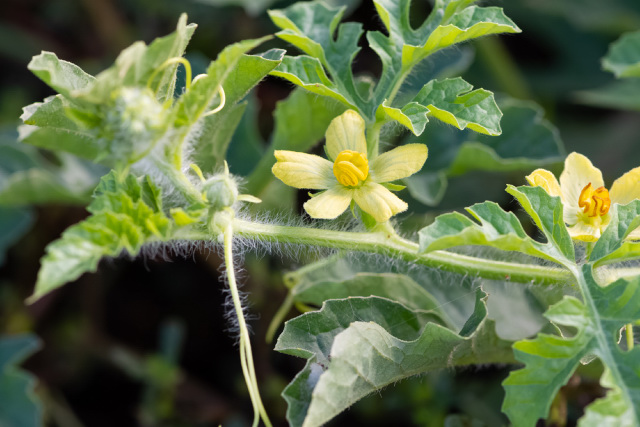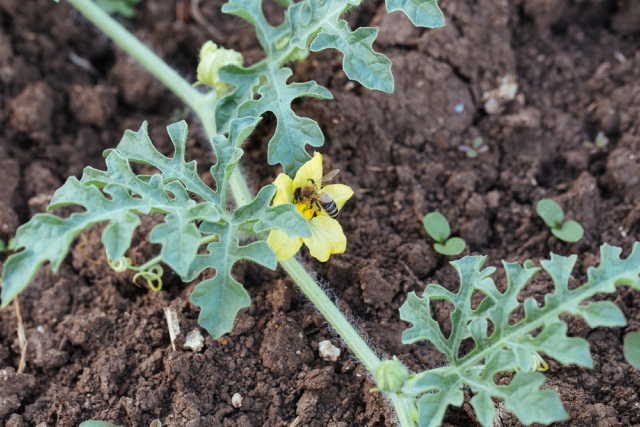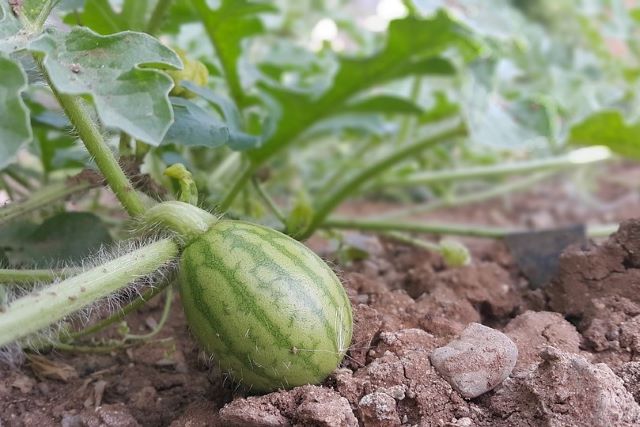I know it can be very frustrating if your watermelon plant is flowering but not producing any fruit. After all, is there anything better than sitting under the summer sun with a chunk of watermelon in your hand? This is quite a common problem, so let’s have a look at the reasons why this is happening, and how we can get your plants to produce some watermelon!

The most common reasons your watermelon plant is flowering but not producing fruit is due to poor pollination, the wrong climate, incorrect soil conditions and insufficient plant spacing.
Let’s look at each one in more detail and how you can fix the problem to turn those watermelon flowers into watermelon fruit.
Table of Contents
Poor Pollination Causes Watermelon Flowers But No Fruit

The most common reasons why your watermelon plants are flowering but not producing fruit is due to a lack of pollination. Pollination occurs when pollen is transferred from the male flower to the female flower.
You can differentiate between male and female flowers by how they are attached and their size.
Male flowers are attached by only thin greenish stems. Males will also bloom first and are smaller flowers. Don’t worry too much if a few of your male flowers fall off prematurely.
Females are attached to an immature watermelon. Female flowers bloom later and are bigger than male flowers. These are the important flowers so let’s see how we can get them to produce you some delicious watermelons in time for the summer heat.
Male flowers are, by nature, expendable; their only function is to produce the pollen to be transferred to the female flower, which forms the fruit from their center. If your female flowers start dropping, this means that your flowers didn’t get pollinated in time. Don’t fret! There are a few solutions to get your pollination back on track.
As bees and other beneficial insect have the job of pollinating your watermelon flowers, you can help attract them into the garden with flowering plants. More bees mean more pollination! You can plant things like lavender, pussy willow, and nasturitium to name a few.
Pollinating Your Watermelon Plants by Hand
If you’re not getting enough benifical insects into the garden, another option is to pollinate the watermelon flowers yourself.
The way you do this is, to use a small clean paint brush (or q-tip) and gently brush inside the male flower. Then brush inside a few female flowers. This will effectively transfer the pollen.
You can also pick a male flower, peel away the petels and then gently brush inside the female flowers.
Incorrect Climate for Growing Watermelons
Watermelon plants require the correct climate to fruit. They need plenty of sun and the right growing temperatures.
Watermelons love the sun. If it’s possible, you’re wanting to give your watermelon plants at least 8 hours of sun. Their optimal growing temperature is between 80 and 90°F (26-32°C).
If you’re in an area that doesn’t get warm enough there are a couple of things that you can do. Covering the soil with a black plastic sheet, with holes around your watermelon plants can aid in warming the soil. You can leave this plastic sheet all year round.
You can also liberally mulch your watermelon plants. This will insulate the watermelon vines and help retain some warmth. Mulching also helps your soil retain moisture, and slow weeds.
Watermelons also need a long growing season up to 120 days. So make sure you are giving your watermelons the right about of time to grow in their preferred growing tempture.
Incorrect Soil Causes Watermelon Flowers But No Fruit

If your watermelon plant is flowering but not producing any fruit, your soil may be the culprit.
The optimal soil for your watermelon plants is soil that is loamy, fertile, and well-draining. Loamy soil is soil that consists of sand, silt, and clay. The soil’s pH level should be between 6.0 and 6.8. You can use a soil test monitor here to check your pH level.
Make sure that your soil is well-draining. If your soil isn’t well-draining, the chances of your soil retaining too much water and causing root rot are high. Since your watermelon plants have shallow roots and require a lot of moisture, your soil must drain well so that it’s moist, and not damp.
You can do this by simply adding a few soil amendments that your watermelon plants will love, such as aged manure (not fresh or bacteria-rich), seaweed, and well-rotted compost. This will help to aerate the soil and increase drainage.
And keep the area around your watermelon plants well-weeded. This is because weeds will compete for the soil nutrients you’re trying to give to your watermelon plants.
Too Much Nitrogen
If your watermelon plants are flowering but not producing fruit it may be due to too much nitrogen in the soil. Although nitrogen-based fertilizer is really good for your watermelon plants in the early stages, it can be quite detrimental once your plant starts to flower.
If you have high concentrations of nitrogen in your soil, you’ll notice an abundance of leaf and root growth. This will be at the cost of producing fruit. You can fix this by using a fertilizer high in phosphorus. Side dressing this with some bone meal in early spring can also go a long way.
Adding fertilizer that is higher in potassium will dramatically boost the productivity of your watermelon plants when flowering and producing fruit. I like this organic edible gardening fertilizer here.
Watermelon Vine Malnutrition
If you see that your watermelon plant is shedding flowers prematurely it could be an issue of malnutrition. Although male flowers do tend to fall off here and there, it’s not a good sign if your female flowers start to fall off.
To bring life back to your watermelon plants, use some fertilizer.
Feed your plants slow–releasing organic fertilizer around the time when the first flower buds start to emerge. This will ensure that they get a healthy growth spurt and that you get your juicy watermelons.
Root Damage Causing Issues with Fruiting
There are a few factors that increase the risk of root damage to watermelon plants. Two of the most prominent ways being competing plants and soil-drainage issues.
Competing plants: Other than weeds, having other plants planted too close to your watermelons can cause issues with growth and also root damage. Give your watermelons plenty of space to grow, without competition from other plants. See ‘incorrect spacing’ below for the right spacing of watermelons.
Soil-Drainage: Water-logged soil or soil that in anyway retains too much water, can cause watermelon plants to rot and drown. So free-draining soil is required for growing healthy watermelon vines that will successfully flower and fruit.
Incorrect Plant Spacing Cause Watermelon Flowers But No Fruit
If your watermelon plants have abundant foliage and few fruits, they might have been spaced incorrectly.
Provide proper air circulation to your watermelon plants, especially after rain. Having well-draining soil is step one, but as an added measure having some good air circulation will ensure that growing conditions are optimal.
You can do this by providing sufficient space between each of your watermelon plants, and planting your watermelon in a nice open space without anything blocking the breeze or providing shade.
Depending on your watermelon variety, smaller watermelons can be planted with placing of 2 feet by 3 feet (60-90cm). While larger watermelon varieties need more room with spacing of 4 feet by 6 feet (1.2-1.8 meter).
Pests Causing Fruiting Issues to Your Watermelon Plants
Pests! They can cause damage to your watermelon plants and cause growth issues by eating them or stealing their nutrients.
One of the best ways to control pests such as Aphids is to have lots of insectary plants growing in your garden that feed the natural predators of these pests. Insectary plants are those that increase pollen and nectar resources for the natural predators of those pesky unwanted pests. By attracting more of these helpful predators you can keep your prized watermelons safe.
If these pests have already invaded your garden in large numbers, you can wash them off with a firm spray of water. You should be careful with this since watermelons are shallow plants. So make sure to care not to damage your plants.
Hopefully, you catch the problem in time and cause use preventative measures for these pests. Otherwise horticultural neem oil or insecticidal soap are excellent organic methods of garden pest control.
Related Reading:
